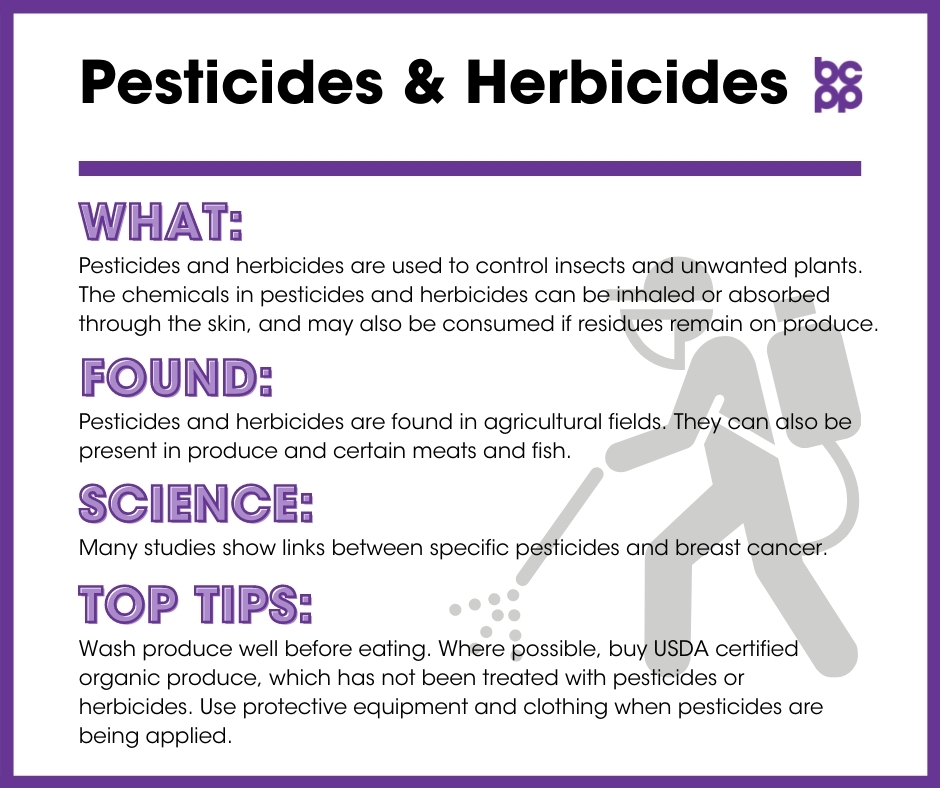Pesticides & Herbicides
At a Glance
Pesticides and herbicides are used to control insects and unwanted plants in agricultural fields. The chemicals in pesticides and herbicides can be inhaled or absorbed through the skin by those who work or live in close vicinity to the fields.
When chemical residues remain on or in produce, meat, or fish, we may also consume these harmful chemicals.
Exposure to the pesticides and herbicides below, especially during critical periods of breast development such as prenatally and in early childhood, is associated with an increased risk for developing breast cancer.
A History of Pesticides
For thousands of years, people in agrarian societies have used natural chemicals, like salt and extracts from various poisonous plants and animals, to kill off unwanted pests and weeds. But since the end of World War II, people have taken advantage of the synthetic chemicals developed for warfare and began to use them for commercial agriculture and general pest removal.
DDT: the First Widely Used Synthetic Pesticide
Most importantly, DDT is a pesticide and insecticide that was sprayed in homes, trenches and fields during WWII to (successfully) stave off malaria and other diseases borne by mosquitos, especially. After the war, spraying programs continued, with DDT and other organochlorine pesticides routinely being sprayed across the world.
In 1962, even as she was dying from breast cancer, Rachel Carson published her extraordinary book, Silent Spring, detailing how DDT was not only killing off mosquitoes, but was also devastating the reproductive abilities of many wildlife species, including the American bald eagle. Within a decade, DDT was banned in the U.S. and most other countries around the world, although its use was retained in areas of sub-Saharan Africa and Asia, especially India, that remained prone to malaria outbreaks.
The Growth of Synthetic Pesticides and Herbicides
While fighting against the evidence of DDT and other organophosphate chemicals’ harm to wildlife and human health, agrichemical and petrochemical industries produced an ever-increasing array of chemicals designed to kill insects and weeds. Many of the insecticides, like DDT, worked mainly by over-exciting the nervous systems of insects, interfering with mechanisms that are common in all animals including humans. Increasingly we learned that many of these chemicals were also direct carcinogens and endocrine disrupting compounds (EDCs). This latter property – being an EDC, especially one that alters the actions of the estrogen pathways – is associated with an increased risk for developing breast cancer, especially when exposures occur during critical periods of breast development such as prenatally and in early childhood.
In parallel with the development of chemicals targeted at insects, increasing amounts of toxic chemicals to kill weeds were applied to agricultural fields, enabling the development of large corporate farms where traditional, ecologically important farming techniques disappeared. Most notable of these so-called herbicides is glyphosate, the major ingredient of Monsanto’s Round-up which was developed in the mid-1970s. Because Roundup actually killed all vegetation on which it was sprayed, its initial applications were limited to rights of way, pipeline areas, between-row cultivation areas, etc. Following Monsanto’s pairing of Roundup with genetically-modified herbicide (glyphosate)-resistant soybean, maize and cotton seeds in the mid 1990’s, the herbicide’s agricultural use has exploded. Many other compounds have been developed by numerous agrichemical companies in an attempt to control weeds and address the growing resistance by crops and their weeds to the chemicals that are sprayed on them by the hundreds of tons each year.
Like the insecticides described above, glyphosate and other herbicides are designed to kill, in this case broad leaf grasses and other weeds. But many have also been shown to be EDCs and the scientific literature is increasingly linking exposures to them, especially at early stages of development, to increased risk for breast cancer.
Pesticides Linked to Breast Cancer
More Pesticides Linked to Breast Cancer
Chlordane, 2,4-D, 2,4,5-TP, and malathion
Chlordane is a pesticide, and 2,4,5-trichlorophenoxy propionic acid (2,4,5-TP) is an herbicide. They are classified as probable and possible human carcinogens by the EPA and the International Agency for Research on Cancer (IARC). Though both were banned in the 1980s, they persist in the environment and can linger in fat tissue for long periods of time.[1],[2]
2,4-dichlorophenoxyacetic acid (2,4-D) is an herbicide that is still used today. It is an endocrine disruptor that has the ability to mimic estrogen. High levels of estrogen are linked to breast cancer. IARC classifies 2,4-D as a possible human carcinogen.[3]
Malathion is a pesticide that is widely used around the world.[4]
Where are these pesticides and herbicides found?
These pesticides and herbicides are found in agricultural fields. They can also be present in produce and certain meats and fish.[6]
What evidence links exposures to these pesticide and herbicides to breast cancer?
Pesticides are occupational hazards for farmers and their families.
- One study found that the combined chemicals in pesticides caused an increased incidence of breast cancer in younger Hispanic farm workers. The chemicals that workers were exposed to included 2,4-D, malathion, and chlordane.[7]
- Another study found that wives of agricultural workers who used 2,4,5-TP and lived close to agricultural sites had a slightly elevated risk for breast cancer.[8] A more recent follow-up of the wives found associations between use of chlorpyrifos and the development of premenopausal breast cancer.[9]
- Researchers found higher levels of several pesticides in breast tumors than in the surrounding healthy fat when the tissues were removed following diagnosis of breast cancer. Within the tumors, higher levels of these pesticides were associated with cellular abnormalities in pathways associated with cell proliferation and cell death.[10]
The city of Arica, Chile, was repeatedly sprayed with malathion during the 1980s. Thirty years later, researchers found that women in this city were 11 times more likely to experience breast cancer than women in the general Chilean population. Their cancer was also more likely to metastasize.[11]
A study on U.S. women with breast cancer found an association between breast cancer mortality and concentration of pesticide chemical mixtures in their blood.[12]
Who is most likely to be exposed to pesticides and herbicides?
Farmers and others who work in, or reside near, agricultural fields are most likely to be exposed to harmful chemicals used in pesticides and herbicides.[13]
Who is most vulnerable to the health effects of pesticides and herbicides?
In a study of women living on Long Island, those who were diagnosed with breast cancer and had high levels of organochlorine compounds (DDT, DDE, chlordane, and other pesticides) in their blood at the time of diagnosis had higher mortality rates five and 15 years later.[14] Exposure to mixtures of pesticide chemicals might be more toxic than exposure to individual chemicals.[15]
Children are also particularly vulnerable, because they are still developing.[16]
What are the top tips to avoid exposure to pesticides and herbicides?
- Wear fitted protective clothing including long sleeves, pants, boots, gloves and masks when exposed to pesticides containing toxic chemicals. Clothing made of synthetic material is more resistant to penetration by pesticides.[17],[18]
- Wash produce well before eating. Where possible, buy USDA certified organic produce, which has not been treated with pesticides or herbicides.
Updated 2021
[1] Environmental Protection Agency. “Health Effects Notebook for Hazardous Air Pollutants: Chlordane.” Last modified May 8, 2020. https://www.epa.gov/sites/production/files/2016-09/documents/chlordane.pdf.
[2] National Center for Biotechnology Information. “PubChem Compound Summary for CID 7158, Fenoprop” PubChem, https://pubchem.ncbi.nlm.nih.gov/compound/Fenoprop. Accessed 17 November, 2020.
[3] Engel, Lawrence S et al. “Pesticide use and breast cancer risk among farmers’ wives in the agricultural health study.” American Journal of Epidemiology 161, 2 (2005): 121-35. doi:10.1093/aje/kwi022
[4] Cabello, Gertrudis et al. “Relation of Breast Cancer and Malathion Aerial Spraying in Arica, Chile.” International Journal of Morphology 31, 2 (2013): 640-645. doi:10.4067/S0717-95022013000200048.
[6] National Center for Biotechnology Information. “PubChem Compound Summary for CID 7158, Fenoprop” PubChem, https://pubchem.ncbi.nlm.nih.gov/compound/Fenoprop. Accessed 17 November, 2020.
[7] Mills, Paul K, and Richard Yang. “Breast cancer risk in Hispanic agricultural workers in California.” International Journal of Occupational and Environmental Health 11, 2 (2005): 123-31. doi:10.1179/oeh.2005.11.2.123.
[8] Engel, Lawrence S et al. “Pesticide use and breast cancer risk among farmers’ wives in the agricultural health study.” American Journal of Epidemiology 161, 2 (2005): 121-35. doi:10.1093/aje/kwi022.
[9] Engel, Lawrence S et al. “Insecticide use and breast cancer risk among farmers’ wives in the agricultural health study.” Environmental Health Perspectives 125, 9 (2017). doi:10.1289/EHP1295.
[10] Eldakroory, S A et al. “Correlation between toxic organochlorine pesticides and breast cancer.” Human & Experimental Toxicology 36, 12 (2017): 1326-1334. doi:10.1177/0960327116685887.
[11] Cabello, Gertrudis et al. “Relation of Breast Cancer and Malathion Aerial Spraying in Arica, Chile.” International Journal of Morphology 31, 2 (2013): 640-645. doi:10.4067/S0717-95022013000200048.
[12] Parada, Humberto Jr et al. “Organochlorine insecticides DDT and chlordane in relation to survival following breast cancer.” International Journal of Cancer 138, 3 (2016): 565-75. doi:10.1002/ijc.29806.
[13] Environmental Protection Agency. “Health Effects Notebook for Hazardous Air Pollutants: Chlordane.” Last modified May 8, 2020. https://www.epa.gov/sites/production/files/2016-09/documents/chlordane.pdf.
[14] Parada, Humberto Jr et al. “Organochlorine insecticides DDT and chlordane in relation to survival following breast cancer.” International Journal of Cancer 138, 3 (2016): 565-75. doi:10.1002/ijc.29806.
[15] Boada, Luis D et al. “Complex organochlorine pesticide mixtures as determinant factor for breast cancer risk: a population-based case-control study in the Canary Islands (Spain).” Environmental Health 11 (2012): 28. doi:10.1186/1476-069X-11-28.
[16] Alexander, Bruce H et al. “Biomonitoring of 2,4-dichlorophenoxyacetic acid exposure and dose in farm families.” Environmental Health Perspectives 115, 3 (2007): 370-6. doi:10.1289/ehp.8869.
[17] Damalas, Christos A, and Spyridon D Koutroubas. “Farmers’ Exposure to Pesticides: Toxicity Types and Ways of Prevention.” Toxics 4, 1 (2016): 1. doi:10.3390/toxics4010001.
[18] Alexander, Bruce H et al. “Biomonitoring of 2,4-dichlorophenoxyacetic acid exposure and dose in farm families.” Environmental Health Perspectives 115, 3 (2007): 370-6. doi:10.1289/ehp.8869.






